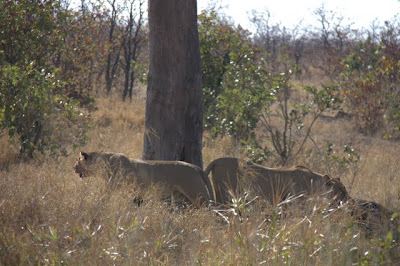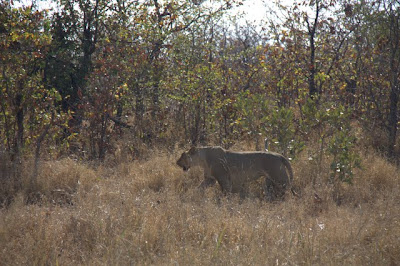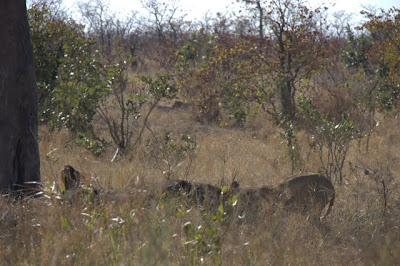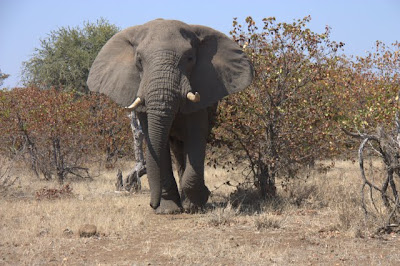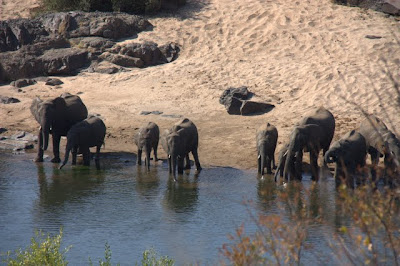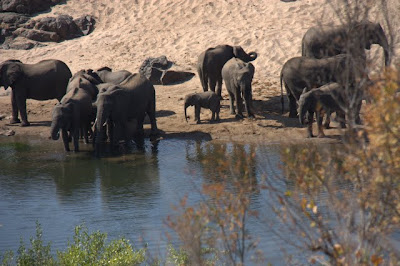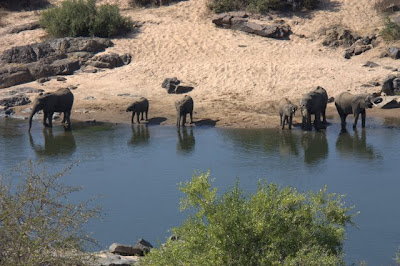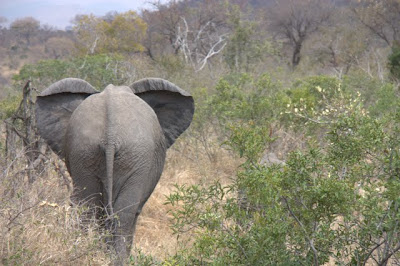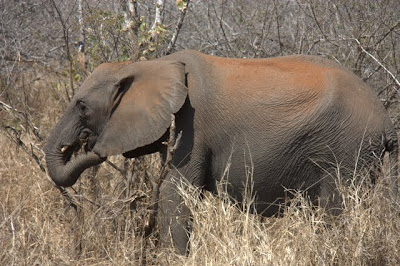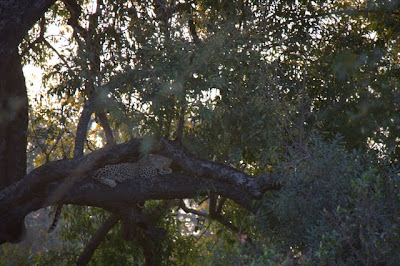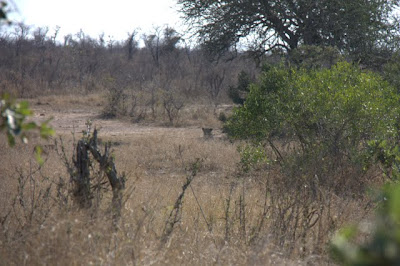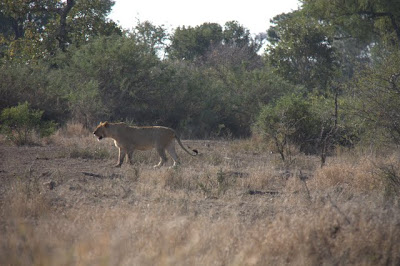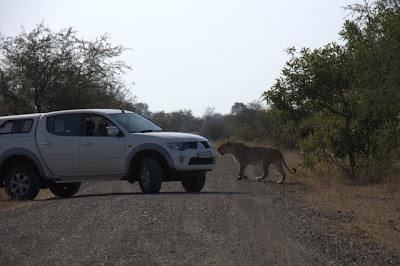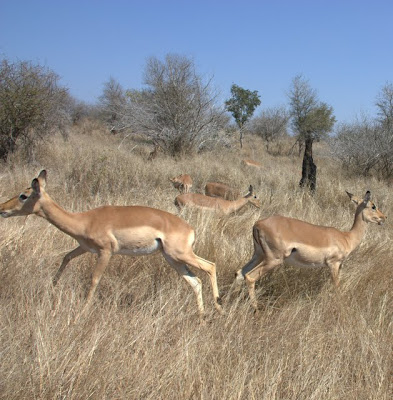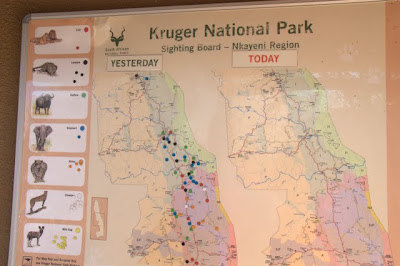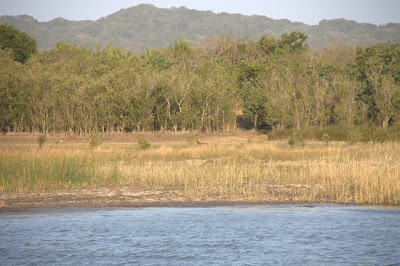Day Four on Safari: Day of the Lion
On our last day in the park, we woke up early and left camp as soon as we could. Within ten minutes, as we drove along the road out of the camp, we saw other early morning safari-goers crowded on the road. We saw that they were watching a female lion down in the valley below.
Pretty cool way to start the day, we thought to ourselves. Little did we know that the lion sightings would just get better. Shortly after we left the area with the female lion, I got out of the car (don’t worry, in a permitted area, although I’m not sure what the difference is, considering there are lions roaming about). I was just about to photograph the sunrise when Sean started shouting for me to get back in. There’s a lion up ahead, he exclaimed. He just crossed the road. Get in! Get in!
We set off in pursuit of the lion. We finally spotted him walking around a clearing set back from the road. It was a male lion, with a full majestic mane. I snapped as many pictures as I could, but since he was on the move and in between brush many of them turned out blurry.
As he paraded around, he periodically let out giant roars. Sean and I were both awestruck at the sound – not something you hear every day.
Then he was on the move, and so were we. For the next half an hour, we followed the lion in our car the best we could. He crossed back and forth over the road and seemed to be patrolling or marking his territory, just like our cat does at home.
It was thrilling to be on the hunt with the lion, but eventually he disappeared out of our sight.
We hung out for a little bit, hoping he would make a return. While we were waiting, we chatted with a South African man in a nearby car. Hear the roars? The man said. There is a lion pride in the valley below. We all grew silent and listened. Sure enough, a low rumble came from off in the distance.
The man then started playing a CD in his truck that contained sounds of a lion roaring. This didn’t seem like the best idea to us – at best, it is just too much interference with the lion’s natural habitat; at worst, for all we knew, it could provoke the lions into attack. Nevertheless, the lions did respond. He would play the CD for a few minutes, and we would then hear the answering roar. But the lions never materialized in our view again.
A couple of hours later, we came across one of the most fascinating – but simultaneously disgusting – scenes from our safari. Sort of the grand finale, I suppose. Even though we were late to the scene, we somehow managed to grab as good of a viewing spot as one could get. Two female lions had recently killed a buffalo near the side of the road. We watched for at least a half hour as one lion stood guard off to the side while the other one had herself a morning snack. We were so close we could hear tearing of the skin and muscle as the lions went to town on the buffalo. Eww. Real life Discovery Channel, I suppose.
Day Three on Safari: Day of the Olifant
It was apparent early on that Day Three was going to be the Day of the Olifant. We stayed at Olifants camp the night before, and the camp doesn’t get its name for nothing. Olifant is Afrikaans for elephant. We saw an absurd amount of elephants our third day.
Here are two of the coolest spottings from Day Three:
Thirsty Elephants
In the late morning, we pulled over to a lookout over a valley close to Olifants Camp. We saw movement off in the distance and watched as a herd of elephants made their way, single file, down to the river for a drink and bath. We watched the elephants for a good half an hour. It was really spectacular to see the elephants carry on their normal business in full view, without them having any idea they had spectators.
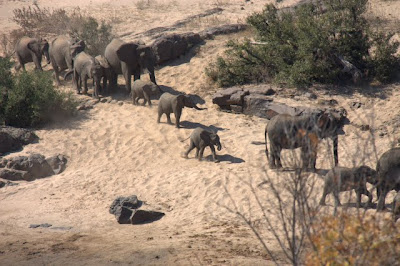
Another herd (or maybe another subset of this herd, who knows) had been waiting patiently but demanded their turn. The first group moved out and let the second herd come to the water.
Elephant Crossing
In the afternoon, we came across a roadblock: an elephant crossing. We noticed elephants always travel in the same way: flanked on either side by the biggest elephants, with the tiniest elephants snug in the middle.
Day One and Day Two on Safari: Big Five
The Big Five: a term referring to the animals that are most notoriously difficult and dangerous to hunt. (Not to be confused with our Belgium Big Five).
We weren’t actually hunting any animals on our safari, of course, other than with our eyes and camera.

Hours of staring into the bush make your eyes play tricks on you. We stared at this rock for at least five minutes, debating whether or not it was some sort of cat, before we realized it was a rock.
It is every safari-goer’s goal to see The Big Five, and some don’t get to complete the task. You’d have to be blind to miss seeing elephants in Kruger, but the leopard and lion can be elusive, sneaky cats. We got lucky and spotted the Big Five by the end of our second day on safari.
1. Elephant:
Elephants were the first member of the Big Five to cross our path and our second animal spotting. We saw an elephant within five minutes of entering the park. Here’s some of the best elephant spottings from Day One and Day Two:
2. Buffalo:
We spotted the second member of the Big Five in the late afternoon of the first day. Their curved horns are pretty cool.
3. Leopard:
Being crazy cat people, we were anxious to see some big old cats of any variety in person. In the waning hours of sunlight on our first day, we came across cars blocking the road. We came to the scene late, so we didn’t get the best viewing spot, but it soon became apparent what all of the commotion was about. A leopard, with all of its glorious spots, was lounging around on a branch up a tree. It turned out to be our only leopard spotting.
4. Lion:
When we didn’t spot any lions on our first day, we were quite disappointed. On our second day, we happened upon a car stopped on the road with its engine off. We asked the young man inside what he was checking out. He pointed to a female lion, off in the distance, resting in the grass in the distance under a tree. Without binoculars, all we could see were her ears.
Later the same day, after driving around for hours without seeing ANYTHING, not even impala, and sometimes not even other cars, we came across a family parked on the side of the road intently staring off in the distance. We pulled up beside them and started chatting with the driver. He was from South Africa, and made outings to Kruger on a regular basis. He loaned us his binoculars to spy on lions far away who were protecting their kill from vultures overhead. Even once we knew where to look, the lions were too far away to see much once we gave the binoculars back. We debated leaving, but decided to hang out for a while in the hopes something would happen. We weren’t having much luck driving around, anyway. About 15 minutes or so later, we saw movement. One of the female lions decided she was thirsty and sauntered across the road within inches of one of the cars that had just pulled up to the scene.
5. Rhino:
Who knew the rhinoceros was such an elusive animal, especially since they are the third most prevalent animal in Kruger? We only saw a group of rhinos once, at the very end of our second day. We didn’t see any again, but our Big Five sightings were complete.
Tips for a DIY Safari in Kruger National Park
Before I show you awesome pictures of animals, let me bore most of you a little bit with the logistics of our safari. When we were planning our foray into Kruger National Park – at the last minute as per usual – reading about other people’s experiences and tips was immensely helpful. Okay, I can’t help myself. I’ll show you some impala, but be patient for the good stuff!
Safaris Don’t Have to be Expensive.
From the beginning, Sean really wanted to go on a safari in Africa. He really wanted to see the Great Migration (an annual event where thousands of wildebeest traverse the Serengeti and Masai Mara with predators in tow). We did some research into costs of a 7 or 10 day safari, and even a no-frills safari with a safari operator would have cost us thousands of dollars each. At some point, we nixed the idea, mostly because of cost and partly because we got distracted with planning the other 355 of this trip. When we were planning our stay in South Africa, we realized it was possible to take a self-drive safari through Kruger National Park in South Africa. Hooray for DIY, just like we like it.
If you have ever dreamed about seeing animals in the wild just like on the Discovery Channel, and cost is the only thing that is stopping you, time to start planning. Self-drive safaris in the Kruger are not only amazing, they are also incredibly affordable. The biggest expense will likely be your plane ticket to South Africa. Overall, we spent $783.61 for a four day, three night self-drive safari in Kruger. Extrapolated to 10 days, this was less than half the cost of even the most budget safari we checked out. That figure includes lodging in the park’s en-suite bungalows; cold meals purchased in advance from Woolworth’s and Pick’n’Play grocery stores in Nelspruit; a dinner and a lunch in the park’s restaurants (which, by the way, are overpriced; we wished we bought more groceries, as even more pricey prepared meals from Woolworths would have been more cost-effective); extra snacks, drinks, and ice inside the park; a nylon cooler from Pick’n’Play; fees for a guided night-drive safari at the Shindgwedzi Camp; gas; and the rental fees for a step-up-from-budget 2-wheel drive car. You can even do Kruger safaris for cheaper, if you are willing to camp or share a bathroom.
Now, you will not have a guide with you, but this also means that you can move around the park at your own pace. We were worried we would have trouble spotting animals, particularly when we drove around for hours the first day and didn’t see anything. The truth is, spotting animals is mostly luck and being in the right place at the right time. There are ways to maximize your sighting potential, described below. Even though we didn’t always follow such tips, overall we didn’t have any trouble spotting animals.
Our sightings (we counted the number of times we saw one or more types of animals, not the total number we saw):
wildebeest (6); buffalo (10); baboons (7); elephants (30); giraffes (14); hippopotamus (1); impala (countless); kudu (4); leopard (1); lions (6); nyala (3); zebra (12); scrub hare (5); serval (1); steenbok (5); vervet monkey (4); warthog (4); waterbuck (5); white rhinoceros (1); turtle (1); crocodile (1); African-fish eagle (2). The only animal we missed out on that we wanted to see were cheetahs – too fast for us, I guess.
Kruger Itinerary and Tips for Spotting Animals on Your Own
Here was our Kruger itinerary:
- Day before: We stayed in Nelspruit (at a great lodge not in the guide books, Khayalami Lodge) and stocked up on supplies.
- Day one: We left Nelspruit mid-morning, entered through the Malelane Gate, drove to Skuzkuza Camp, arrived mid-afternoon, and went back out for a couple of hours around close.
- Day two: We left around 7 a.m., drove from Skuzkuza Camp to Olifants Camp, got there mid-afternoon, went back out for a couple of hours around close, and went on the guided night drive.
- Day three: We slept in, left around 9 a.m., drove from Olifants Camp to Shingwedzi Camp, got there mid-afternoon, and went back out for a couple of hours around close.
- Day four: We left around 6 a.m., drove from Shingwedzi Camp to Phalaborwa Gate, exited, and drove to Graskop/Sabie in the afternoon.
If we had to do it over again, we would have still stayed three nights. We felt that was a good amount of time to make sure we had an opportunity to see most of the animals we wanted to see, cover a good bit of the park without rushing, and not get bored. However, we would have spent multiple nights at the same camp. This allows you to dawdle in good areas, especially in the early morning and late afternoon, and rest mid-day. We quickly learned that very early morning (about 6 to 8 a.m.) and very late afternoon (about 4 to 6 p.m.) is the best time to spot the most interesting animals and has the best lighting for pictures to boot. It really is worth getting up to leave right at 6:00. Even by 7:00 a.m., the animals that had been roaming around at night already have retreated deep into the bush.
The way we did it was fine, but it required us to drive many hours during the boring mid-day to get to the next camp, when the animal sightings are few and far between because most of them are sleeping. Everyone makes safaris sound so exciting, but the truth is you can easily spent hours driving where you see absolutely no animals except for countless impala, a type of antelope that is no longer exciting to see after the second or third time. (Although we did see our first good lion sighting in the smack dab middle of the day, so you never know…)

Me, out loud on Safari: Damn it, impala, why aren't the lions chasing you and eating you? And I call myself an animal lover. For shame. What can I say, the call of the wild gets to you.
Satara is a good camp at which to base yourselves, because it is situated in an area where there are a lot of Big Five sightings. If Satara is booked, like it was for us, Olifants is a good alternative that isn’t too far away and near good sightings. Some people complain that the area around Satara is too crowded, and that you can feel more “one with nature” in other areas, but we never were distracted by other people, and we were there during one of the high seasons (August, during winter, when you the brush is not as dense). Plus, we didn’t have binoculars, so sometimes a group of cars helped us spot a really good sighting we wouldn’t have noticed otherwise.
We also found it helpful to check out the sightings board at each of the camp, so we would know more about the activity in the area.
We didn’t hesitate to ask people in nearby cars what they were looking at, and we reciprocated by passing along information to people driving by. Finally, if you find a good animal, or have a clear view, make sure you hang out for a while. You will often see some action if you are patient.
Hungry Hippos
While we were staying St. Lucia, the town near the St. Lucia estuary, we heard tales of Vincent the Hippopotamus, who was often seen wandering the streets of the town. Vincent got his name because he only had one ear, like Vincent van Gogh. We didn’t see Vincent or any of his hippo friends on the streets of St. Lucia. But we did see lots of hippos and crocodiles in the waters of the estuary on a boat cruise. My goal was to get a photograph of a hippo in action with a big yawn, but that turned out to be harder than I thought since most of them were just big sleepy lumps in the water. Really big lumps.

Did you know that hippos don't swim? When they need to cross deep water, they just sink to the bottom, hold their breath, and walk across the bottom.
As a prelude to our safari to come, our eagle eyed guide spotted a leopard on the shore. Sean and I both learned we have horrible eyesight, because it was hard for us to see the dot even after our guide pointed it out. Luckily, the wildlife in Kruger would be easy to spot….more on that tomorrow!





